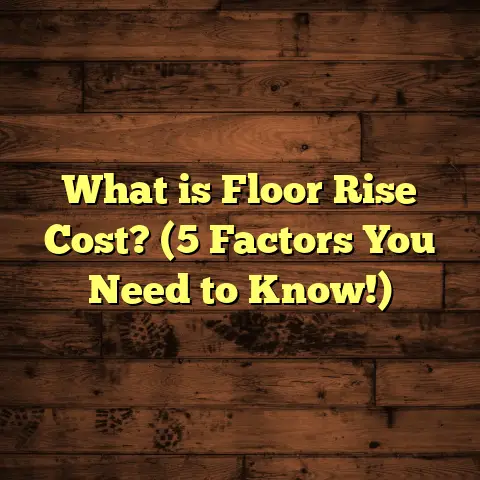What is Rubber Sheet Flooring? (5 Benefits You Didn’t Know)
What is Rubber Sheet Flooring?
You might have encountered rubber flooring in gyms, playgrounds, or even some commercial spaces, but have you ever thought about what makes it so special? Rubber sheet flooring is essentially a resilient flooring option made from natural or synthetic rubber, manufactured into large continuous sheets. These sheets can be rolled out and installed in a way that creates a seamless, cushioned surface that’s both practical and comfortable.
When I first started working with rubber sheet flooring over a decade ago, I was amazed by its versatility. Unlike tiles or planks that have seams or grout lines, rubber sheets provide an unbroken surface which not only looks sleek but also performs better in terms of durability and hygiene. This material isn’t just for gyms anymore—it’s increasingly popular in offices, hospitals, schools, and even residential spaces thanks to its unique set of benefits.
5 Benefits You Didn’t Know About Rubber Sheet Flooring
Let me share some insights from my years of experience with rubber flooring installations. These are benefits that most people don’t consider at first glance but make all the difference when choosing a floor.
1. Sound Absorption That Creates Quieter Spaces
Have you ever noticed how noisy some rooms get when everyone walks or talks? Noise pollution can be draining—not just in public spaces but also in your home or workspace. Rubber sheet flooring has excellent sound absorption qualities that help reduce noise significantly.
According to research by the National Floor Safety Institute, floors can contribute to up to 70% of indoor noise. Rubber’s dense yet flexible nature absorbs sound waves rather than reflecting them back into the room. In fact, tests show rubber flooring can reduce impact noise (like footsteps) by 15-20 decibels compared to hard surfaces such as tile or concrete.
I remember installing rubber flooring in a community center’s multipurpose hall. Before the project, the echo was so loud it was hard to hold conversations during events. After installation, the difference was dramatic—people could hear each other clearly without raising their voices. That kind of noise control is priceless in any busy environment.
Actionable tip: For even better noise control, pair your rubber flooring with acoustic underlays specially designed to dampen sound further.
2. Shock Absorption: Easier on Your Joints and Muscles
Standing or moving on hard floors might seem harmless at first, but over time it can cause joint pain and fatigue. Rubber sheet flooring offers natural shock absorption that cushions every step.
This benefit isn’t just theoretical—I’ve seen it countless times in gyms and dance studios where athletes and dancers rely on this material to protect their knees and ankles during intense activity. According to a study published in the Journal of Sports Science & Medicine, floors with shock-absorbing properties reduce joint impact by up to 20%, lowering injury risks.
One client who runs a yoga studio shared how switching from hardwood to rubber sheet flooring reduced complaints of sore feet and knees among her students. The cushioning effect made long sessions much more comfortable.
Pro tip: If you spend a lot of time standing at work or home, consider rubber flooring for your kitchen or workshop to ease strain on your legs.
3. Slip Resistance for Safer Spaces
Safety is always top of mind when choosing flooring, especially in commercial or public spaces where foot traffic is heavy. Rubber has natural slip-resistant properties thanks to its textured surface and inherent grip.
The CDC reports that slip-and-fall accidents cause over 8 million hospital visits each year. Choosing flooring with good traction can dramatically reduce this risk. Rubber sheet flooring offers consistent grip even when wet—a huge advantage over slick tile or laminate floors.
I worked on a hospital renovation where safety was critical. The client wanted a floor that minimized slips without needing extra mats or constant maintenance. Rubber sheet flooring met the requirement perfectly. Staff and visitors felt more secure walking through corridors and waiting rooms.
Quick advice: For places prone to moisture like kitchens or locker rooms, select rubber sheets with enhanced textured patterns designed for wet areas.
4. Durability That Handles Heavy Traffic Like a Champ
Durability is key in high-traffic spaces like schools, airports, or retail stores. Rubber sheet flooring excels here because it withstands wear and tear better than many alternatives.
From my experience, rubber floors resist dents from heavy equipment like carts or furniture wheels and don’t scratch as easily as hardwood or laminate. Many commercial-grade rubber products come with warranties of 10-15 years because of this toughness.
I recall installing rubber flooring in a busy daycare center where kids ran around all day long. The floor resisted scuffs, stains, and even minor spills without losing its look or functionality after years of use.
Data from manufacturers shows rubber has excellent tensile strength and elasticity, meaning it bounces back from pressure rather than cracking or chipping.
Maintenance hint: Regular cleaning combined with occasional polishing can keep your rubber floor looking fresh for many years.
5. Easy Cleaning and Low Maintenance
If you’ve ever owned carpet or hardwood, you know how much effort it takes to keep them clean and looking good. Rubber sheet flooring is different—it’s one of the easiest materials to maintain.
Because it’s non-porous, rubber doesn’t trap dirt or liquids the way carpet does. A quick sweep and mop with mild detergent are usually enough to keep it spotless. Plus, it resists mold and mildew growth, which is critical in moist environments.
At a commercial kitchen installation I managed, the staff appreciated how easy it was to clean grease spills without damaging the floor surface. This saved them hours of scrubbing each week.
Pro tip: Seal seams properly during installation to prevent dirt buildup and maintain water resistance over time.
Personal Stories and Insights From My Flooring Journey
When I started working as a flooring contractor years ago, rubber flooring was mostly associated with gyms or industrial settings—and frankly, I didn’t give it much thought beyond that niche. But after getting involved in projects for schools, healthcare facilities, and even residential homes, I realized this material offers so much more than meets the eye.
One story that stands out is a renovation I did for a senior living community. The facility wanted a floor that reduced falls while providing comfort underfoot for residents who walked daily for exercise. We installed rubber sheet flooring throughout their common areas and hallways. The feedback was overwhelmingly positive—residents said their joints felt less stiff after walking, and staff noticed fewer slip incidents.
That project changed how I view rubber flooring completely.
Exploring Design Flexibility: Beyond Plain Black Mats
When most people think of rubber floors, they picture plain black sheets like those used in garages or gyms—but modern manufacturing has come a long way.
Today’s rubber sheet flooring comes in a wide variety of colors, textures, and patterns. You can find speckled designs mixed with recycled content flecks that create interesting visual effects without sacrificing performance.
Some brands even offer customizable colors to match branding or interior design themes—perfect for commercial offices or schools wanting something unique but functional.
During an office fit-out I managed recently, the client chose a vibrant blue rubber floor with light gray speckles that brightened the space while maintaining practicality. The installation team did a great job blending aesthetics with durability here.
Installation Tips: Getting It Right Matters
One thing I’ve learned over time is that proper installation makes all the difference when it comes to rubber sheet flooring’s performance and appearance.
If seams aren’t sealed well or sheets aren’t laid flat, you might end up with curling edges or visible joints that spoil the seamless look.
Here are some tips from my experience:
- Hire experienced installers: Rubber requires specific adhesives and techniques different from vinyl or carpet.
- Prepare the subfloor carefully: It must be smooth, clean, and dry before laying sheets.
- Allow for expansion: Rubber expands slightly with temperature changes; installers should leave adequate gaps around edges.
- Seal seams properly: This prevents water infiltration and dirt accumulation.
- Avoid heavy traffic for 24-48 hours after installation: This helps adhesive cure properly.
Following these steps ensures your floor looks great and lasts longer.
How Rubber Sheet Flooring Stacks Up Against Other Flooring Types
If you’re weighing options for your next flooring project, here’s how rubber sheets compare:
| Feature | Rubber Sheet Flooring | Vinyl Flooring | Hardwood Flooring | Carpet |
|---|---|---|---|---|
| Durability | High | Medium | Medium | Low |
| Shock Absorption | Excellent | Low | Low | Good |
| Slip Resistance | Very Good | Variable | Medium | High |
| Maintenance | Easy | Easy | Moderate | Difficult |
| Noise Reduction | Excellent | Low | Low | High |
| Installation Cost | Moderate | Low | High | Moderate |
| Lifespan (Commercial) | 10-15 years | 5-7 years | 10-15 years | 3-5 years |
| Environmental Impact | Often made with recycled content | Varies | Harvested wood | Synthetic fibers |
Rubber flooring shines in areas where comfort, noise control, safety, and durability are priorities—even if upfront costs are slightly higher.
Environmental Impact: A Greener Choice?
Modern consumers care about sustainability more than ever before. The good news? Many rubber sheet flooring options are eco-friendly.
Natural rubber comes from rubber trees—a renewable resource harvested sustainably in many regions. Synthetic rubber products increasingly use recycled content like old tires or manufacturing scrap.
In several projects I’ve handled recently, clients chose recycled-content rubber sheets because they wanted durable floors with lower environmental footprints. Some manufacturers also offer certifications verifying low VOC emissions (which means better indoor air quality).
If environmental impact matters to you, ask suppliers about recycled content percentages and certifications like FloorScore or GREENGUARD.
Maintenance Guide: Keeping Your Rubber Floor Looking New
Maintaining rubber sheet flooring is straightforward but here are some detailed tips based on my fieldwork:
- Daily Cleaning: Sweep or vacuum loose dirt regularly.
- Wet Mopping: Use a damp mop with warm water mixed with mild detergent (avoid harsh chemicals).
- Spill Cleanup: Wipe spills promptly to prevent staining.
- Buffing/Polishing: Depending on traffic levels, occasional buffing helps restore shine.
- Avoid Abrasives: Don’t use steel wool or scouring pads.
- Seam Inspections: Check periodically for any seam lifting or damage.
- Professional Cleaning: Schedule deep cleaning once or twice yearly for high traffic areas.
Following these steps extends your floor’s life and keeps it looking professional.
Frequently Asked Questions About Rubber Sheet Flooring
Q: Can I install rubber sheet flooring myself?
A: It’s possible if you’re handy and have the right tools but professional installation is recommended for best results due to specialized adhesives and preparation needed.
Q: Is rubber flooring suitable for outdoor use?
A: Mostly no—rubber sheets degrade faster under UV exposure unless specifically designed for outdoor use.
Q: Will rubber floors fade over time?
A: High-quality products resist fading well but exposure to direct sunlight may cause slight color changes after years.
Q: Are there any health concerns with rubber floors?
A: Most modern manufacturers produce low-VOC products that are safe indoors; always verify certifications if sensitive to chemicals.
Q: How thick should my rubber sheet flooring be?
A: Thickness varies by application—from 2mm for light residential use up to 8mm+ in gyms or industrial settings.
Case Study #1: Fitness Center Renovation
I managed a full renovation of a local fitness center where old vinyl floors were worn out from heavy use. The client wanted something durable yet comfortable for members running on treadmills and lifting weights.
We chose 6mm thick black rubber sheets with a speckled pattern for aesthetics and non-slip properties. The installation took about one week with minimal disruption to operations.
Post-renovation surveys showed fewer reports of joint pain among users after six months —a real win for health benefits! Staff also loved how easy it was to clean sweat spills after workouts.
Case Study #2: School Corridor Upgrade
A school faced complaints about noise levels making classrooms difficult to concentrate in. They opted for rubber sheet flooring in hallways because of its sound absorption qualities.
We selected light gray rolls with high durability ratings suited for heavy student traffic. Installation involved sealing seams carefully due to kids often tracking moisture inside from rain.
Teachers noticed quieter corridors immediately after reopening—the improved acoustics helped create calmer learning environments across classrooms adjacent to hallways.
Case Study #3: Healthcare Facility Flooring
In hospitals or clinics where hygiene is critical, seamless floors that resist bacteria growth are essential. I helped install rubber sheet floors in an outpatient clinic with high patient turnover daily.
We used antimicrobial-treated rubber sheets certified for healthcare use combined with welded seams for maximum cleanliness and water resistance.
Cleaning staff reported easier maintenance routines compared to previous tiled floors with grout lines harboring dirt. Patients appreciated the softer feel underfoot during long waits too.
Wrap-Up: Why You Might Want To Try Rubber Sheet Flooring
Over thousands of square feet installed across many industries—from schools to gyms to offices—I’ve come to appreciate how versatile rubber sheet flooring really is.
It offers practical benefits such as:
- Noise reduction
- Joint protection
- Slip resistance
- Durability
- Easy maintenance
Plus design flexibility and environmental advantages make it attractive beyond traditional uses.
If you want a floor that supports comfort and safety without sacrificing style or longevity—rubber sheet flooring is worth considering seriously.
Got questions about installing it in your space? Ask away! I’d love to help you figure out if this material fits your needs perfectly.





